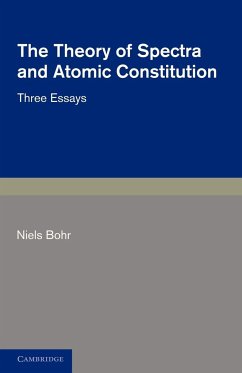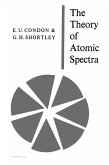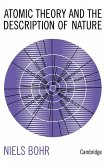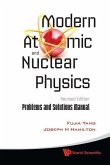- Broschiertes Buch
- Merkliste
- Auf die Merkliste
- Bewerten Bewerten
- Teilen
- Produkt teilen
- Produkterinnerung
- Produkterinnerung
- Weitere 6 Ausgaben:
- Gebundenes Buch
- Gebundenes Buch
- Broschiertes Buch
- Broschiertes Buch
- Broschiertes Buch
- Broschiertes Buch
Niels Bohr (1885â 1962) was a Danish physicist who played a key role in the development of atomic theory and quantum mechanics, he was awarded the Nobel Prize for Physics in 1922. This 1924 second edition contains three essays dealing with the application of quantum theory to problems of atomic structure.
Andere Kunden interessierten sich auch für
![The Theory of Atomic Spectra The Theory of Atomic Spectra]() E. U. CondonThe Theory of Atomic Spectra62,99 €
E. U. CondonThe Theory of Atomic Spectra62,99 €![Atomic Theory and the Description of Nature Atomic Theory and the Description of Nature]() Niels BohrAtomic Theory and the Description of Nature32,99 €
Niels BohrAtomic Theory and the Description of Nature32,99 €![Atomic Spectra and Atomic Structure Atomic Spectra and Atomic Structure]() Gerhard HerzbergAtomic Spectra and Atomic Structure30,99 €
Gerhard HerzbergAtomic Spectra and Atomic Structure30,99 €![Escape From Shadow Physics Escape From Shadow Physics]() Adam Forrest KayEscape From Shadow Physics26,99 €
Adam Forrest KayEscape From Shadow Physics26,99 €![The New Cosmic Onion The New Cosmic Onion]() Frank Close (UK University of Oxford)The New Cosmic Onion68,99 €
Frank Close (UK University of Oxford)The New Cosmic Onion68,99 €![Modern Atomic and Nuclear Physics (Revised Edition): Problems and Solutions Manual Modern Atomic and Nuclear Physics (Revised Edition): Problems and Solutions Manual]() Fujia Yang (China Fudan Univ & Uk Univ Of Nottingham)Modern Atomic and Nuclear Physics (Revised Edition): Problems and Solutions Manual19,99 €
Fujia Yang (China Fudan Univ & Uk Univ Of Nottingham)Modern Atomic and Nuclear Physics (Revised Edition): Problems and Solutions Manual19,99 €![Escape From Shadow Physics Escape From Shadow Physics]() Adam Forrest KayEscape From Shadow Physics14,99 €
Adam Forrest KayEscape From Shadow Physics14,99 €-
-
-
Niels Bohr (1885â 1962) was a Danish physicist who played a key role in the development of atomic theory and quantum mechanics, he was awarded the Nobel Prize for Physics in 1922. This 1924 second edition contains three essays dealing with the application of quantum theory to problems of atomic structure.
Hinweis: Dieser Artikel kann nur an eine deutsche Lieferadresse ausgeliefert werden.
Hinweis: Dieser Artikel kann nur an eine deutsche Lieferadresse ausgeliefert werden.
Produktdetails
- Produktdetails
- Verlag: Cambridge University Press
- Seitenzahl: 150
- Erscheinungstermin: 9. März 2011
- Englisch
- Abmessung: 216mm x 140mm x 8mm
- Gewicht: 208g
- ISBN-13: 9781107669819
- ISBN-10: 1107669812
- Artikelnr.: 33624996
- Herstellerkennzeichnung
- Libri GmbH
- Europaallee 1
- 36244 Bad Hersfeld
- gpsr@libri.de
- Verlag: Cambridge University Press
- Seitenzahl: 150
- Erscheinungstermin: 9. März 2011
- Englisch
- Abmessung: 216mm x 140mm x 8mm
- Gewicht: 208g
- ISBN-13: 9781107669819
- ISBN-10: 1107669812
- Artikelnr.: 33624996
- Herstellerkennzeichnung
- Libri GmbH
- Europaallee 1
- 36244 Bad Hersfeld
- gpsr@libri.de
Part I. On the Spectrum of Hydrogen: 1. Empirical spectral laws
2. Laws of temperature radiation
3. The nuclear theory of the atom
4. Quantum theory of spectra
5. Hydrogen spectrum
6. The Pickering lines
7. Other spectra
Part II. On the Series Spectra of the Elements
Section 1. Introduction
Section 2. General Principles of the Quantum Theory of Spectra: 8. Hydrogen spectrum
9. The correspondence principle
10. General spectral laws
11. Absorption and excitation of radiation
Section 3. Development of the Quantum Theory of Spectra: 12. Effect of external forces on the hydrogen spectrum
13. The Stark effect
14. The Zoeman effect
15. Central pertubations
16. Relativity effect of hydrogen lines
17. Theory of series spectra
18. Correspondence principle and conservation of angular momentum
19. The spectra of helium and lithium
20. Complex structure of series lines
Section 4. Conclusion
Part III. The Structure of the Atom and the Physical and Chemical Properties of the Elements
Section 5. Preliminary: 21. The nuclear atom
22. The postulates of the quantum theory
23. Hydrogen atom
24. Hydrogen spectrum and x-ray spectra
25. The fine structure of the hydrogen lines
26. Periodic table
27. Recent atomic models
Section 6. Series Spectra and the Capture of Electrons by Atoms: 28. Arc and spark spectra
29. Series diagram
30. Correspondence principle
Section 7. Formation of Atoms and the Periodic Table: 31. First period. Hydrogen-helium
32. Second period. Lithium-neon
33. Third period. Sodium-argon
34. Fourth period. Potassium-Krypton
35. Fifth period. Rubidium-xenon
36. Sixth period. Caesium-niton
37. Seventh period
38. Survey of the periodic table
Section 8. Reorganization of Atoms and X-Ray SPectra: 39. Absorption and emission of x-rays and correspondence principle
40. X-ray spectra and atomic structure
41. Classification of x-ray spectra
42. Conclusion
Appendix.
2. Laws of temperature radiation
3. The nuclear theory of the atom
4. Quantum theory of spectra
5. Hydrogen spectrum
6. The Pickering lines
7. Other spectra
Part II. On the Series Spectra of the Elements
Section 1. Introduction
Section 2. General Principles of the Quantum Theory of Spectra: 8. Hydrogen spectrum
9. The correspondence principle
10. General spectral laws
11. Absorption and excitation of radiation
Section 3. Development of the Quantum Theory of Spectra: 12. Effect of external forces on the hydrogen spectrum
13. The Stark effect
14. The Zoeman effect
15. Central pertubations
16. Relativity effect of hydrogen lines
17. Theory of series spectra
18. Correspondence principle and conservation of angular momentum
19. The spectra of helium and lithium
20. Complex structure of series lines
Section 4. Conclusion
Part III. The Structure of the Atom and the Physical and Chemical Properties of the Elements
Section 5. Preliminary: 21. The nuclear atom
22. The postulates of the quantum theory
23. Hydrogen atom
24. Hydrogen spectrum and x-ray spectra
25. The fine structure of the hydrogen lines
26. Periodic table
27. Recent atomic models
Section 6. Series Spectra and the Capture of Electrons by Atoms: 28. Arc and spark spectra
29. Series diagram
30. Correspondence principle
Section 7. Formation of Atoms and the Periodic Table: 31. First period. Hydrogen-helium
32. Second period. Lithium-neon
33. Third period. Sodium-argon
34. Fourth period. Potassium-Krypton
35. Fifth period. Rubidium-xenon
36. Sixth period. Caesium-niton
37. Seventh period
38. Survey of the periodic table
Section 8. Reorganization of Atoms and X-Ray SPectra: 39. Absorption and emission of x-rays and correspondence principle
40. X-ray spectra and atomic structure
41. Classification of x-ray spectra
42. Conclusion
Appendix.
Part I. On the Spectrum of Hydrogen: 1. Empirical spectral laws
2. Laws of temperature radiation
3. The nuclear theory of the atom
4. Quantum theory of spectra
5. Hydrogen spectrum
6. The Pickering lines
7. Other spectra
Part II. On the Series Spectra of the Elements
Section 1. Introduction
Section 2. General Principles of the Quantum Theory of Spectra: 8. Hydrogen spectrum
9. The correspondence principle
10. General spectral laws
11. Absorption and excitation of radiation
Section 3. Development of the Quantum Theory of Spectra: 12. Effect of external forces on the hydrogen spectrum
13. The Stark effect
14. The Zoeman effect
15. Central pertubations
16. Relativity effect of hydrogen lines
17. Theory of series spectra
18. Correspondence principle and conservation of angular momentum
19. The spectra of helium and lithium
20. Complex structure of series lines
Section 4. Conclusion
Part III. The Structure of the Atom and the Physical and Chemical Properties of the Elements
Section 5. Preliminary: 21. The nuclear atom
22. The postulates of the quantum theory
23. Hydrogen atom
24. Hydrogen spectrum and x-ray spectra
25. The fine structure of the hydrogen lines
26. Periodic table
27. Recent atomic models
Section 6. Series Spectra and the Capture of Electrons by Atoms: 28. Arc and spark spectra
29. Series diagram
30. Correspondence principle
Section 7. Formation of Atoms and the Periodic Table: 31. First period. Hydrogen-helium
32. Second period. Lithium-neon
33. Third period. Sodium-argon
34. Fourth period. Potassium-Krypton
35. Fifth period. Rubidium-xenon
36. Sixth period. Caesium-niton
37. Seventh period
38. Survey of the periodic table
Section 8. Reorganization of Atoms and X-Ray SPectra: 39. Absorption and emission of x-rays and correspondence principle
40. X-ray spectra and atomic structure
41. Classification of x-ray spectra
42. Conclusion
Appendix.
2. Laws of temperature radiation
3. The nuclear theory of the atom
4. Quantum theory of spectra
5. Hydrogen spectrum
6. The Pickering lines
7. Other spectra
Part II. On the Series Spectra of the Elements
Section 1. Introduction
Section 2. General Principles of the Quantum Theory of Spectra: 8. Hydrogen spectrum
9. The correspondence principle
10. General spectral laws
11. Absorption and excitation of radiation
Section 3. Development of the Quantum Theory of Spectra: 12. Effect of external forces on the hydrogen spectrum
13. The Stark effect
14. The Zoeman effect
15. Central pertubations
16. Relativity effect of hydrogen lines
17. Theory of series spectra
18. Correspondence principle and conservation of angular momentum
19. The spectra of helium and lithium
20. Complex structure of series lines
Section 4. Conclusion
Part III. The Structure of the Atom and the Physical and Chemical Properties of the Elements
Section 5. Preliminary: 21. The nuclear atom
22. The postulates of the quantum theory
23. Hydrogen atom
24. Hydrogen spectrum and x-ray spectra
25. The fine structure of the hydrogen lines
26. Periodic table
27. Recent atomic models
Section 6. Series Spectra and the Capture of Electrons by Atoms: 28. Arc and spark spectra
29. Series diagram
30. Correspondence principle
Section 7. Formation of Atoms and the Periodic Table: 31. First period. Hydrogen-helium
32. Second period. Lithium-neon
33. Third period. Sodium-argon
34. Fourth period. Potassium-Krypton
35. Fifth period. Rubidium-xenon
36. Sixth period. Caesium-niton
37. Seventh period
38. Survey of the periodic table
Section 8. Reorganization of Atoms and X-Ray SPectra: 39. Absorption and emission of x-rays and correspondence principle
40. X-ray spectra and atomic structure
41. Classification of x-ray spectra
42. Conclusion
Appendix.









